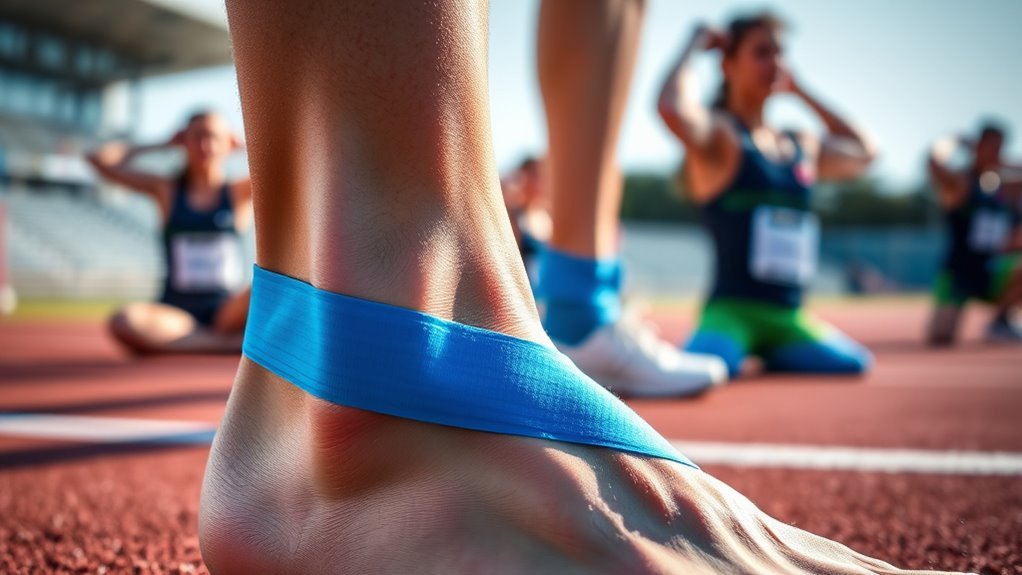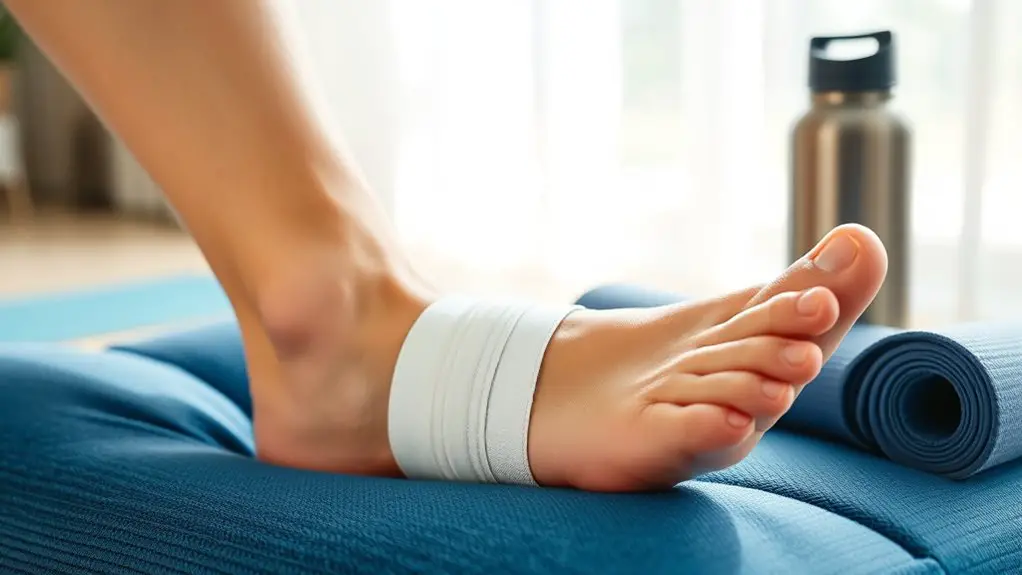Athletes wear tape for several reasons. It helps prevent injuries by providing joint and muscle support. If you’re dealing with an existing injury, tape stabilizes it while allowing movement. Taping can also enhance your performance by improving agility and proprioception. Plus, it offers psychological benefits by boosting your confidence and reducing anxiety during competition. To understand the different types of tape available and how they can support you further, keep exploring the topic.
The Role of Athletic Tape in Injury Prevention
While you might think of athletic tape as just another accessory for athletes, it plays an essential role in injury prevention. When you’re pushing your limits, injury management becomes vital. Proper tape application can provide the support you need, allowing you to move freely without fear of strain. It stabilizes joints and muscles, reducing the risk of injuries while you chase your goals. By using athletic tape, you empower yourself to perform at your best, knowing you’ve taken steps to protect your body. This simple tool can be the difference between finishing strong or sidelining yourself. Sprains and strains are common injuries that can be mitigated with proper tape support. Embrace the freedom that comes with feeling secure in your movements, and let athletic tape be your ally in your active lifestyle.
Supporting Existing Injuries With Tape
When you’re recovering from an injury, athletic tape becomes an essential tool in your rehabilitation arsenal. It provides the rehabilitation support you need to get back on your feet without risking further damage. By using tape, you can achieve effective injury stabilization, allowing you to move freely while still protecting the affected area. This support helps maintain your range of motion and reduces pain, empowering you to stay active during your recovery. Taping techniques can be tailored to your specific injury, ensuring that you’re not restricted but rather supported. Embracing this method means you can regain your confidence and independence, releasing the freedom to continue pursuing your athletic passions while healing. Additionally, listening to the body is crucial during recovery to ensure that you are not overexerting yourself and that the injury is healing properly.
Enhancing Performance Through Taping Techniques
Taping techniques do more than just support existing injuries; they can also enhance overall athletic performance. By strategically applying tape, you can optimize your movement and boost your strength. These methods help improve proprioception, giving you a better sense of body positioning, which is essential for agility and speed. When you feel more aware of your body’s mechanics, you can push your limits while reducing the risk of injury. Additionally, taping can provide a sense of stability, allowing you to focus entirely on your performance rather than worrying about potential setbacks. This enhanced proprioceptive awareness not only aids in navigating environments confidently but also contributes to better movement efficiency. So, whether you’re sprinting down the track or making that game-winning shot, these performance enhancement strategies could give you the edge you’ve been looking for.
Different Types of Athletic Tape and Their Uses
Athletes have a variety of tape options at their disposal, each designed for specific needs and purposes. Kinesiology tape, for instance, offers flexibility and support, allowing for a full range of motion while promoting blood flow and reducing pain. It’s great if you want to feel free while still getting the support you need. On the other hand, rigid tape provides a more solid structure, perfect for immobilizing joints or stabilizing injuries. This type can restrict movement, making it ideal for acute injuries or when you need extra protection during intense activities. Choosing the right tape depends on your needs, so don’t hesitate to experiment and find what works best for you!
The Psychological Benefits of Wearing Tape
Choosing the right tape isn’t just about physical support; it can also provide significant psychological benefits. When you wrap your joints or muscles, you might experience a confidence boost and enhanced mental focus. Here are three ways tape can elevate your game:
- Sense of Security: By stabilizing your body, tape can help you feel more secure, reducing anxiety during intense moments.
- Ritual and Routine: Taping can become a pre-game ritual, mentally preparing you for performance and creating a sense of control.
- Positive Association: If you associate tape with past successes, it can trigger confidence and motivate you to push harder.
Incorporating tape into your routine can be that extra edge, allowing you to perform freely and fearlessly. Additionally, utilizing breathing techniques can further enhance your focus and calmness during competition, complementing the psychological benefits of taping.
Frequently Asked Questions
Can Anyone Use Athletic Tape, or Is It Only for Professionals?
Anyone can use athletic tape, not just professionals! If you’re looking to support your muscles or joints, you can definitely benefit from it. Tape benefits include enhanced stability and reduced injury risk. By learning some basic taping techniques, you can easily apply it yourself. Whether you’re training hard or just staying active, using tape can give you that extra freedom to push your limits without worrying about potential strains or sprains.
How Long Can Athletic Tape Be Worn Before Needing Replacement?
You can typically wear athletic tape for up to three days before needing replacement. Some might think that tape durability means it can last longer, but it’s best to change it regularly to guarantee effectiveness and prevent skin irritation. Depending on your activity level, you might need to replace it more frequently. Prioritizing your comfort and mobility gives you the freedom to perform at your best, so don’t hesitate to swap it out as needed!
Does Taping Affect Flexibility or Range of Motion?
Taping can impact flexibility and range of motion, but it largely depends on the taping techniques used. If applied correctly, it shouldn’t restrict your movements considerably. However, you might have some flexibility concerns if the tape’s too tight or improperly placed. It’s all about finding the right balance—enjoying support without sacrificing your freedom of movement. So, make sure you communicate with your trainer about what feels best for you.
Is There a Specific Technique for Applying Tape Effectively?
Absolutely, there are specific taping techniques for proper application that can enhance support without limiting your movement. You might worry about it feeling restrictive, but when done right, tape can actually promote freedom in your motions. Start by ensuring the area is clean and dry, then apply the tape with just enough tension to support without pulling too tight. Experiment with different techniques to find what works best for you and your activity.
Can Tape Cause Skin Irritation or Allergic Reactions?
Yes, tape can definitely cause skin irritation or allergic reactions. If you’ve got skin sensitivity, you might experience allergic dermatitis from certain tape materials or adhesives. It’s vital to test a small area before applying it extensively. If you notice redness, itching, or a rash, it’s best to remove the tape and consult a healthcare professional. Your skin’s comfort should always come first, so don’t hesitate to explore alternatives if needed.




